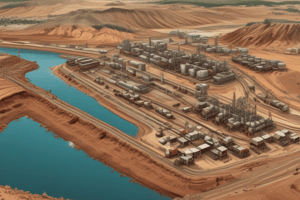Podcast
Questions and Answers
What is one of the key aspects of evaluating the impact of tailings on human health?
What is one of the key aspects of evaluating the impact of tailings on human health?
- Simulating the behavior of water in the tailings deposit
- Evaluating the risks associated with exposure to tailings (correct)
- Assessing the effects of water contamination on local wildlife
- Monitoring the stability of the tailings deposit
Which tool is used to evaluate the capacity of the tailings deposit to prevent water contamination?
Which tool is used to evaluate the capacity of the tailings deposit to prevent water contamination?
- Hydrological modeling (correct)
- Monitoring
- Risk analysis
- Stability analysis
What is the primary goal of monitoring the tailings deposit?
What is the primary goal of monitoring the tailings deposit?
- To evaluate the risks associated with exposure to tailings
- To assess the impact of the deposit on local wildlife
- To detect any changes in the stability or containment capacity of the deposit (correct)
- To simulate the behavior of water in the deposit
What is the focus of the 'Impactos ambientales' aspect of evaluating tailings?
What is the focus of the 'Impactos ambientales' aspect of evaluating tailings?
What is the purpose of stability analysis in evaluating tailings?
What is the purpose of stability analysis in evaluating tailings?
What is the main purpose of evaluating a tailings deposit?
What is the main purpose of evaluating a tailings deposit?
What is the primary focus of the recognition phase of the evaluation process?
What is the primary focus of the recognition phase of the evaluation process?
What is a key aspect of evaluating the stability of a tailings deposit?
What is a key aspect of evaluating the stability of a tailings deposit?
What is the main goal of the evaluation phase focused on the capacity of the deposit to contain the tailings?
What is the main goal of the evaluation phase focused on the capacity of the deposit to contain the tailings?
What is the primary objective of the recommendations and mitigation measures phase?
What is the primary objective of the recommendations and mitigation measures phase?
What is a key parameter of evaluation in the assessment of a tailings deposit?
What is a key parameter of evaluation in the assessment of a tailings deposit?
What is the main risk associated with a tailings deposit?
What is the main risk associated with a tailings deposit?
What is the primary goal of evaluating a tailings deposit's capacity to contain the tailings?
What is the primary goal of evaluating a tailings deposit's capacity to contain the tailings?
Flashcards are hidden until you start studying
Study Notes
Evaluación de depósitos de relaves
Introducción
- Evaluación de depósitos de relaves es un proceso importante para determinar la seguridad y el impacto ambiental de un depósito de relaves.
- Un depósito de relaves es un lugar donde se almacenan los residuos de la minería, como rocas y minerales no económicamente viables.
Objetivos de la evaluación
- Identificar los riesgos potenciales asociados con el depósito de relaves.
- Evaluar la estabilidad del depósito y su capacidad para contener los relaves.
- Determinar la capacidad del depósito para prevenir la contaminación del agua y el suelo.
- Establecer medidas para mitigar los impactos ambientales y sociales.
Fases de la evaluación
- Reconocimiento: Recopilar información sobre el depósito de relaves, incluyendo su ubicación, geología y hidrología.
- Identificación de riesgos: Identificar los riesgos potenciales asociados con el depósito de relaves, como la contaminación del agua y el suelo, la estabilidad del depósito y los impactos en la salud humana.
- Análisis de datos: Analizar los datos recopilados para evaluar la severidad de los riesgos identificados.
- Evaluación de la estabilidad: Evaluar la estabilidad del depósito de relaves, incluyendo su capacidad para contener los relaves y resistir eventos naturales como terremotos y lluvias intensas.
- Evaluación de la capacidad de contención: Evaluar la capacidad del depósito para prevenir la contaminación del agua y el suelo.
- Recomendaciones y medidas de mitigación: Establecer medidas para mitigar los impactos ambientales y sociales identificados.
Parámetros de evaluación
- Estabilidad del depósito: Incluye la evaluación de la capacidad del depósito para resistir eventos naturales y la estabilidad del terreno.
- Capacidad de contención: Incluye la evaluación de la capacidad del depósito para prevenir la contaminación del agua y el suelo.
- Impactos en la salud humana: Incluye la evaluación de los riesgos para la salud humana asociados con la exposición a los relaves.
- Impactos ambientales: Incluye la evaluación de los impactos en el medio ambiente, como la contaminación del agua y el suelo, y la pérdida de biodiversidad.
Herramientas y técnicas de evaluación
- Análisis de riesgos: Identificar y evaluar los riesgos potenciales asociados con el depósito de relaves.
- Modelado hidrológico: Simular el comportamiento del agua en el depósito de relaves y evaluar la capacidad del depósito para prevenir la contaminación del agua.
- Análisis de estabilidad: Evaluar la estabilidad del depósito de relaves y su capacidad para resistir eventos naturales.
- Monitoreo: Realizar un seguimiento continuo del depósito de relaves para detectar cualquier cambio en su estabilidad o capacidad de contención.
Evaluación de Depósitos de Relaves
Introduction
- Evaluation of tailings deposits is a crucial process to determine the safety and environmental impact of a tailings deposit.
- A tailings deposit is a storage site for mining waste, including uneconomical rocks and minerals.
Objectives of Evaluation
- Identify potential risks associated with the tailings deposit.
- Evaluate the stability of the deposit and its ability to contain the tailings.
- Determine the deposit's capacity to prevent water and soil contamination.
- Establish measures to mitigate environmental and social impacts.
Phases of Evaluation
- Reconnaissance: Gather information about the tailings deposit, including location, geology, and hydrology.
- Risk Identification: Identify potential risks associated with the tailings deposit, such as water and soil contamination, deposit instability, and human health impacts.
- Data Analysis: Analyze collected data to evaluate the severity of identified risks.
- Stability Evaluation: Evaluate the deposit's stability, including its ability to contain the tailings and resist natural events like earthquakes and heavy rainfall.
- Containment Capacity Evaluation: Evaluate the deposit's ability to prevent water and soil contamination.
- Recommendations and Mitigation Measures: Establish measures to mitigate identified environmental and social impacts.
Evaluation Parameters
- Deposit Stability: Evaluate the deposit's ability to resist natural events and ground stability.
- Containment Capacity: Evaluate the deposit's ability to prevent water and soil contamination.
- Human Health Impacts: Evaluate risks to human health associated with tailings exposure.
- Environmental Impacts: Evaluate environmental impacts, including water and soil contamination, and biodiversity loss.
Evaluation Tools and Techniques
- Risk Analysis: Identify and evaluate potential risks associated with the tailings deposit.
- Hydrological Modeling: Simulate water behavior in the tailings deposit and evaluate the deposit's ability to prevent water contamination.
- Stability Analysis: Evaluate the deposit's stability and ability to resist natural events.
- Monitoring: Continuously monitor the tailings deposit to detect any changes in its stability or containment capacity.
Studying That Suits You
Use AI to generate personalized quizzes and flashcards to suit your learning preferences.




